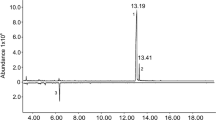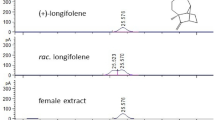Abstract
WE report for the first time a synergistic effect on the pheromone response of a bark beetle species (Coleoptera: Scolytidae) by the pheromone of a sympatric species. Ips avulsus Eichh. and I. grandicollis Eichh. are two sympatric Ips species often found colonising the same host tree in the southern USA. Male I. avulsus produce the pheromone ipsdienol (2-methyl-6-methylene-2,7-octadiene-4-ol)1,2 and both sexes are attracted to this compound in the field3. Male I. grandicollis produce the pheromone ipsenol (2-methyl-6-methylene-7-octene-4-ol)1,2,4 and both sexes respond to the S-(–)-isomer5. I. avulsus is known to respond in low numbers to both the crude attractant6 and infested host material7 of I. grandicollis. To investigate this relationship, a series of tests was carried out in east Texas. Two to four tree trunk-simulating olfactometers8 set 10 m apart adjacent to a loblolly pine stand at Lufkin, Texas, were baited with test material during the afternoon, when flight of I. avulsus occurred. Test materials included the optically pure enantiomers of ipsenol9, racemic mixtures of ipsenol and ipsdienol, and billets infested with male I. avulsus and I. grandicollis. All test materials used in a test series were offered simultaneously.
This is a preview of subscription content, access via your institution
Access options
Subscribe to this journal
Receive 51 print issues and online access
$199.00 per year
only $3.90 per issue
Buy this article
- Purchase on Springer Link
- Instant access to full article PDF
Prices may be subject to local taxes which are calculated during checkout
Similar content being viewed by others
References
Vité, J. P., Bakke, A., and Renwick, J. A. A., Can. Entom., 104, 1967–1975 (1972).
Hughes, P. R., J. Insect Physiol., 20, 127–1275 (1974).
Renwick, J. A. A., and Vité, J. P., J. Insect Physiol., 18, 1215–1219 (1972).
Vité, J. P., and Renwick, J. A. A., J. Insect Physiol., 17, 1699–1704 (1971).
Vité, J. P., Hedden, R. L., and Mori, K., Naturwissenschaften, 63, 43 (1976).
Vité, J. P., and Pitman, G. B., Proc. XIV Int. Union Forest Res. Org., 24, 683–701 (1967).
Vité, J. P., Gara, R. I., and Von Schiller, H. D., Contrib. Boyce Thompson Inst., 22, 461–470 (1964).
Vité, J. P., and Pitman, G. B., Can. Entom., 101, 113–117 (1969).
Mori, K., Tetrahedron Lett., 2187 (1975); Tetrahedron (in the press).
Atkins, M. D., Can. Entom., 98, 285–288 (1966).
Wood, D. L., in Control of Insect Behaviour by Natural Products, 301–316 (Academic, New York, 1970).
Lanier, G. N., and Burkholder, W. E., in Pheromones, 161–189 (North-Holland, Amsterdam, 1974).
Birch, M. C., and Wood, D. L., J. chem. Ecol., 1, 101–113 (1975).
Author information
Authors and Affiliations
Rights and permissions
About this article
Cite this article
HEDDEN, R., VITE, J. & MORI, K. Synergistic effect of a pheromone and a kairomone on host selection and colonisation by Ips avulsus. Nature 261, 696–697 (1976). https://doi.org/10.1038/261696a0
Received:
Accepted:
Published:
Issue Date:
DOI: https://doi.org/10.1038/261696a0
This article is cited by
-
Genetic Control of the Enantiomeric Composition of Ipsdienol in the Pine Engraver, Ips pini
Journal of Chemical Ecology (2006)
-
Enantiomeric composition of ipsdienol: A chemotaxonomic character for north American populations ofIps spp. in thepini subgeneric group (coleoptera: Scolytidae)
Journal of Chemical Ecology (1995)
-
Green leaf volatiles interrupt aggregation pheromone response in bark beetles infesting southern pines
Experientia (1992)
-
Ipsenol: an aggregation pheromone forIps latidens (Leconte) (Coleoptera: Scolytidae)
Journal of Chemical Ecology (1991)
-
Olfactory-based behavioral interactions among five species in the southern pine bark beetle group
Journal of Chemical Ecology (1990)
Comments
By submitting a comment you agree to abide by our Terms and Community Guidelines. If you find something abusive or that does not comply with our terms or guidelines please flag it as inappropriate.



